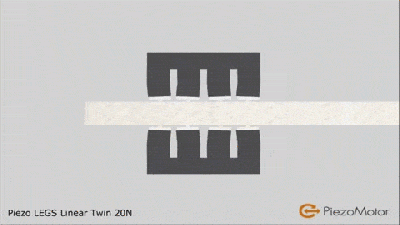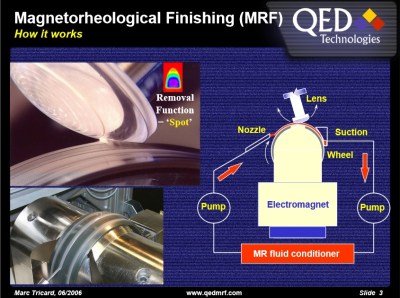Motors are everywhere; DC motors, AC motors, steppers, and a host of others. In this article, I’m going to look beyond these common devices and search out more esoteric and unusual electronic actuators that might just find a place in one of your projects. In any case, their mechanisms are interesting in their own right! Join me after the break for a survey of piezo, magnetostrictive, magnetorheological, voice coils, galvonometers, and other devices. I’d love to hear about your favorite actuators and motors too, so please comment below!
Piezo actuators and motors

Piezoelectric materials sometimes seem magic. Apply a voltage to a piezoelectric material and it will move, as simple as that. The catch of course is that it doesn’t move very much. The piezoelectric device you’re probably most familiar with is the humble buzzer. You’d usually drive these with less than 10 volts. While a buzzer will produce a clearly audible sound you can’t really see it flexing (as it does shown above).
To gauge the motion of a buzzer I recently attempted to drive one with a 150 volt piezo driver, this resulted in a total deflection of around 0.1mm. Not very much by normal standards!

For some applications however resolution is of primary interest rather than range of travel. It is here that piezo actuators really shine. The poster-boy application of piezo actuators is perhaps the scanning probe microscope. These often require sub-nanometer accuracy (less than 1000th of 1000th of 1 millimeter) in order to visualize individual atoms. Piezo stacks are ideal here (though hackers have also used cheap buzzers!).
Sometimes though you need high precision over a larger range of travel. There are a number of piezo configurations that allow this. Notably Inchworm, “LEGS”, and slip-stick actuators.
The PiezoMotor LEGS actuator is shown to the above. As noted, Piezos only produce small (generally sub-millimeter) motion. Rather than using this motion directly, LEGS uses this motion to “walk” along a rod, pushing it back and forth. The rod is therefore moved, in tiny nanometer steps. However, piezos can move quickly (flexing thousands of times a second). And the LEGS (and similar Inchworm actuator) allows relatively quick, high force, and high resolution motion.


The tablecloth trick (yes this one’s fake, the kid is ok don’t worry. :))
Another type of long travel piezo actuator uses the “stick-slip phenomenon”. This is much like the tablecloth magic trick shown above. If you pull the cloth slowly there will be significant friction between the cloth and this crockery and they will be dragged along with the cloth. Pull it quickly and there will be less friction and the crockery will remain in place.
This difference between static and dynamic friction is exploited in stick-slip actuators. The basic mechanism is shown in the figure below.

When extending slowing a jaw rotates a screw, but if the piezo stack is compressed quickly the screw will not return. The screw can therefore be made to rotate. By inverting the process (extending quickly, then compressing slowly) the process is reversed and the screw is turned in the opposite direction. The neat thing about this configuration is that it retains much of the piezo’s original precision. Picomotors have resolutions of around 30 nanometer over a huge range of travel, typically 25mm, they’re typically used for optical focusing and alignment and can be picked up on eBay for 100 dollars or so. Oh and they can also be used to make music. Favorites include Stairway to Heaven, and not 1 but 2 versions of Still Alive (from Portal). Obligatory Imperial March demonstration is embedded here:
There are numerous other piezo configurations, but typically they are used to provide high force, high precision motion. I document a few more over on my blog.
Magnetostrictive actuators
Magnetostriction is the tendency of a material to change shape under a magnetic field. We’ve been talking about magnetostriction quite a lot lately. However much like piezos it can also be used for high precision motion. Unlike piezos they require relatively low voltages for operation and have found niche applications.
Magnetorheological motion
Magnetorheological (MR) fluids are pretty awesome! Much like ferrofluids, MR fluids respond to changes in magnetic field strength. However, unlike ferrofluids it’s their viscosity that changes.
 This novel characteristic has found applications in a number of areas. In particularly the finishing of precise mirrors and lens used in semiconductor and astronomical applications. This method uses an electromagnet to change the viscosity of the slurry used to polish mirrors, removing imperfections. The Hubble telescope’s highly accurate mirrors were apparently finished using this technique (though hopefully not that mirror). You can purchase MR fluid in small quantities for a few hundred dollars.
This novel characteristic has found applications in a number of areas. In particularly the finishing of precise mirrors and lens used in semiconductor and astronomical applications. This method uses an electromagnet to change the viscosity of the slurry used to polish mirrors, removing imperfections. The Hubble telescope’s highly accurate mirrors were apparently finished using this technique (though hopefully not that mirror). You can purchase MR fluid in small quantities for a few hundred dollars.
Electrostatic motors
While magnetic motors operate through the attraction and repulsion of magnetic fields, electrostatic motors exploit the attraction and repulsion of electric change to produce motion. Electrostatic forces are orders or magnitude smaller that magnetic ones. However they do have niche applications. One such application is MEMS motors, tiny (often less than 0.01mm) sized nanofabricated motors. At these scales electromagnetic coils would be too large and specific power (power per unit volume) is more important than the magnitude of the overall force.
Voice coils and Galvanometers
The voice coil is your basic electromagnet. They’re commonly used in speakers, where an electromagnet in the cone reacts against a fixed magnet to produce motion. However voice coil like configurations are used for precise motion control elsewhere (for example to focus the lens of an optical drive, or position the read head of a hard disc drive). One of the cooler applications however is the mirror galvanometer. As the name implies the device was originally used to measure small currents. A current through a coil moved a rod to which a mirror was attached. A beam of light reflect off the mirror and on to a wall effectively created a very long pointer, amplifying the signal.
These days ammeters are far more sensitive of course, but the mirror galvanometer has found more entertaining applications:
High speed laser “galvos” are used to position a laser beam producing awesome light shows. Modern systems can position a laser beam at kilohertz speeds, rendering startling images. These systems are effectively high speed vector graphic like line drawing systems, resulting in a number of interesting algorithmic challenges. Marcan’s OpenLase framework provides a host of tools for solving these challenges effectively, and is well worth checking out.
In this article I’ve tried to highlight some interesting and lesser known techniques for creating motion in electronic systems. Most of these have niche scientific, industrial or artistic applications. But I hope they also also offer inspiration as you work on your own hacks! If you have a favorite, lesser known actuator or motor please comment below!















Neat stuff! Since the slip-stick is already a slide rule, how about a “sticktion motor” using a popular term for static friction in physics? But inchworms are fantastic. Someone make an affordable inchworm! Please! I would it I could but I can’t.
I would have chosen this as an example for openlase – https://www.youtube.com/watch?v=5A9Eh6D-K_g it used a lot more tweaks to reduce blinking.
yea, I figured it’s almost too good though! On a video it’s hard to tell it’s a laser and not a rendering. Marcan’s stuff is awesome though, particularly impressive that it extract/render the image from video in realtime.
Yea, fair enough, I won’t argue with your reasoning (much :) ). For some reason that logic reminds of the film/TV cliche “Whenever you see someone driving, even on straight and smooth roads, they are sawing at the wheel hard enough to be running an obstacle course.” You basically show people historically what they expect, instead of what they really would see.
Granted, historically you would need to saw at the wheel pretty hard even on a straight road because of the slop in the steering in historic cars.
Another one:
Wax Actuator / motor https://en.wikipedia.org/wiki/Wax_motor Used primarly to open the cleaning agent bay of the dishwasher.
Regarding Piezo actuators: one trick to get higher displacement is a mechanical amplification e.g., a lever.
Finally, further fascinatig application of Piezo materials would be SAW filters ( https://en.wikipedia.org/wiki/Surface_acoustic_wave ) where you use the mechanical vibration behaviour to filter electronic signals (with inverse piezo effect => piezo effect).
yep, there are a range of amplified stacks which I think go to a few hundred microns e.g. (http://www.cedrat-technologies.com/en/mechatronic-products/actuators/apa.html). I thought this buzzer hack from youtube was pretty cool too (https://www.youtube.com/watch?v=FODtm93mJ-w) but I can’t find much information about it. The wax motor seems rather neat. I wonder why they’re used in dishwashers specifically. Thanks for posting these!
Wax motors are very reliable, cheap, strong, self resetting,they are even used for space grade pin pullers (hold down and releas mechanisms in space applications mentionend here: http://www.esa.int/Our_Activities/Space_Engineering_Technology/Mechanisms/Hold-Down_and_Separation_Systems ), huge temp range (as long as below the liquidus temp.), but very slowly and bad timeable (one reason to use explosive bolts on satellite separation mechanisms).
Wax actuators are also used in the humble automotive coolant thermostat in probably 99.9999% (if not 100%) of cars and trucks today. Virtually any/every liquid cooled engine. These actuators are very, very reliable and they tend to fail stuck open rather than shut. I don’t know the numbers, but I suspect that overheats are more often caused by other factors than the failure of the thermostat.
Volvo used a wax motor to close a preheat vent in the engine air filter box once the engine warms up. Unfortunately, they tend to fail CLOSED, keeping the vent open well past when the engine as warmed up. Has the effect of basically melting the mass-airflow sensor from the excessive heat.
Luckily they used very thin aluminum tubing for the preheat tube which tears easily and is almost always broken.
VW managed to make thermostats that would fail closed.
They’re also used as choke mechanisms in carburetors for small 4-stroke motors.
Not all electrostatic motors are small!
http://www.c-motive.com/our-technology-products/
neat! Thanks for posting that, an interesting find.
Looks like production of those things could be automated much more easily than copper motor windings. This could be a winner.
What about SMAs?
Most DC motors are really AC motors on the inside. Edison’s DC motors were, in reality, running on alternating current — the alternation of the polarity was being caused by a fancy mechanical switching system known as a commutator. Same with brushless DC motors — they depend on electronics to reverse the polarity of the current at the right moments.
“fancy mechanical switching system known as a commutator.”
Really? It’s the most basic and simple thing ever.
Also there is a difference between switching between windings and between switching polarity you know.
Well you know now at least.
Switching the current connected to the windings, switching the windings connected to the current. In a DC motor it’s the same thing. Just different points of view.
Reversing the direction might be called AC, but just jumping to another winding while the direction of the flow remains the same can’t be called AC, is what I was arguing.
So why are picomotors so incredibly expensive that even on ebay they would be 100 bucks?
I mean there are plenty tiny parts you can get for pennies, and piezo parts are amongst those.
Anybody got any information what makes those motors so expensive?
All these piezo motors (especially those with stiction / friction / steppin) need very tight tolerances and defined surfaces. There is further a high stroke tolerance on piezo parts even in the same batch and it is not trivial to drive them -fast- (high voltages 30 .. 200 V with high cap load).
But there are many things with tight tolerance and defined surfaces that are surprisingly low cost though.
I guess it’s about low volume, and perhaps also a lot about monopoly and patents? Patents can really bite the cost of things.
It partially depends on how you get to that surface.
If you have something with a tight tolerance, but it’s:
1) Circular
2) Big enough to fit a reamer in
3) Can be made of a metal or plastic
then it’s cheap to make.
Have something that’s tight tolerance, but is a microfluidic channel that has 3d structure made out of some weird biocompatible material? Price is a *tad* different.
The piezo stacks themselves are not cheap (10s of USD). Fine adjuster screws also 10s of USD. Everything is obviously precision machined. Overall though I’d guess it’s because there’s a smallish market (no consumer applications) so you have to recoup R&D costs and don’t get the cost reductions possible with volume manufacturing.
A few modern HVAC systems use piezo valves to control the refrigerant flow, but that’s hardly a low cost application.
I like the 6-DOF Magnetically-Levitated Precision Planar Motion Stage.
There is a good video here: https://www.youtube.com/watch?v=-r4Tv7GbB8o
Wow [Nava], that’s a lot of info.
Electrostatic motors also come in linear configurations. The interesting part is that the object moved need not be an active element. I’ve seen a simple PCB with electrostatic elements etched onto it, that will move an ordinary sheet of paper placed on top back and forth. Movement in 2D, and spinning the paper, is also possible – with increased complexity.
A video demonstration, this is not a precision version, but still manages some fancy motion: https://www.youtube.com/watch?v=WH5lssgfZWo
Muscle wire! I tried to get my boss to let me use it in one of our products, and even made a cool kinetic sculpture with it. It ran for 10s of thousands of cycles without issue. Apparently it can be extremely precise too, but only if there is position feedback. The Leonardo museum in Salt Lake City has a huge sculpture that uses muscle wire, but I can’t find a video of it…
Yeah muscle wire rules ! I used it to sync a pen to midi music. Worked well, see my hackaday.io page :
https://hackaday.io/project/8870-duke-nukem-dancing-marker-midi-muscle-wire
Youtube: https://www.youtube.com/watch?v=5fiA2lAmTac
I developed this thermal actuator 2017. The DIY is easy. Two strips of polyethylene held together by a double-sided adhesive heat-insulating film. Polypropylene works too.
Question: the figure with the caption “The flexing of a piezo buzzer from arcbotics” shows the same polarity of signal for each direction of deflection. This seems wrong. Shouldn’t the signal polarity be opposite for each deflection?
Phased array acoustic Beam vibratiom technology produces a steerable multiposition sonic beam. Thought of as an actuator component it can energize an arrangement or array of various different motionizing forms.